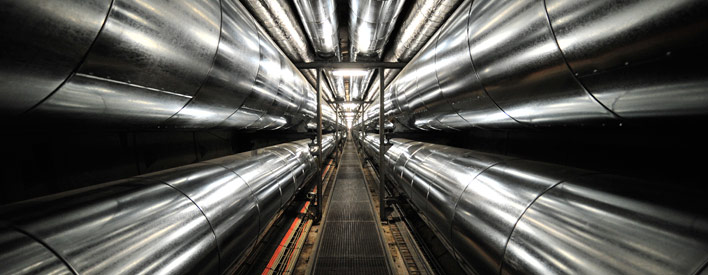
Energy Efficiency and Sustainability
Energy efficiency is defined as using less energy to provide the same product or service, such as lighting, heating and transportation. Together with the move to renewable energy sources, increasing energy efficiency is considered to be one of the twin pillars of sustainable energy policy.
Energy efficiency is key to ensuring a safe and reliable reduction in energy consumption and greenhouse gas emissions.
As energy efficiency is a cheap and abundant resource, possessed by all countries, rich and poor alike, it is key to ensuring a safe and reliable reduction in energy consumption and greenhouse gas emissions. In addition, energy efficiency improvements are by far the quickest and least costly solution to the climate crisis.
Energy-efficiency experts worldwide have identified several areas where the greatest savings in the use of energy can be made, including industry, transport, homes and buildings, and recycling.
The International Energy Agency (IEA) has stated that improved energy efficiency in industrial processes, transportation, and buildings could lead to a 30% reduction in the world’s energy needs by 2050 and help control global emissions of greenhouse gases.
Energy Efficiency in Industry
The global energy intensity of industry—measured as the amount of primary energy demand needed to produce one unit of gross domestic product (GDP)—fell by nearly 20% between 2000 and 2016, primarily as a result of energy efficiency policies. The size of these reductions is similar both in the 29 member countries of the IEA and in major emerging economies. Out of the hundreds of opportunities for substantial savings specific to large industries that have been identified by energy-efficiency experts, four are frequently mentioned as being among the most valuable: more efficient motors, capturing and recycling wasted thermal energy, steel production, and fluid handling.
Enormous savings for industry can be made by replacing older inefficient electric motors with far more efficient modern motors.
Inefficient electric motors are found throughout the global industrial sector. Enormous savings for industry can be made by replacing older inefficient electric motors with far more efficient modern motors, producing savings that exceed the purchase price after just a few weeks of usage, even when the cost of lost production time while replacing the motors is taken into account. These newer industrial motors are almost always easier to operate, quieter and more reliable.
The steel industry has saved huge amounts of energy and drastically reduced CO2 emissions through advances known as “thin-slab casting” and “direct casting”. Traditionally, steel mills have heated steel twice; first, to melt the metals into thick cast sheets, and then a second time in order to recast the steel into the particular form desired. The new, more efficient process involves directly casting the steel from its liquid state into the final form desired, with the added bonus of producing both a lighter and stronger steel than with the older process, as well as being 20 percent cheaper to produce.
Further savings for industries such as paper milling have been achieved through the use of more efficient fluid handling. By redesigning piping systems to optimize fluid flow, and by replacing older, oversized and inefficient pumps with more efficient, modern pumps, many companies have reduced maintenance and production costs, made huge energy savings, increased productivity, and achieved greater reliability and product quality.
Large amounts of heat are produced by most industrial facilities and this wasted thermal energy can be profitably captured and reused
Large amounts of heat are produced by most industrial facilities and this wasted thermal energy can be profitably captured and reused, or sold for heating and cooling nearby buildings. CHP (combined heat and power) systems, also known as cogeneration systems, use the thermal energy produced during electricity production to turn turbines to produce more electricity, effectively using fuel twice and significantly and profitably increasing efficiency in a short period of time. Studies carried out in the U.S. have shown that fossil fuel use and CO2 emissions could be reduced by 20 percent if all wasted thermal energy from factories were to be captured and recycled.
Many European cities use district heating and cooling systems, where hot water generated at a single point of supply is piped under the streets and into heat exchangers and absorption chillers for heating and cooling nearby buildings, including large institutions such as universities and hospitals. Finland is one of the world leaders in the use of CHP and district heating and cooling systems. According to the International Energy Agency’s CHP/DHC Collaborative, CHP produces 74% of Finland’s district heating. The system has generated so much electricity that the surplus is sold to other countries in Scandinavia.
The U.S. Energy Information Administration (EIA) estimates that lighting accounted for approximately 7% of total U.S. electricity consumption in 2017. The potential savings from the use of new LED lightbulbs to replace older, incandescent bulbs are truly astounding, not only for homeowners and businesses, but also for towns and cities through the use of more efficient street lighting. Switching to LED lighting can yield energy savings of over 75%. By 2022, 90% of indoor lighting worldwide is expected to be provided by compact fluorescent lamps (CFLs) and LEDs. In addition, intelligent use of motion sensors to detect when people are present can also be used to achieve further savings and reductions in emissions.
Efficient Homes and Buildings
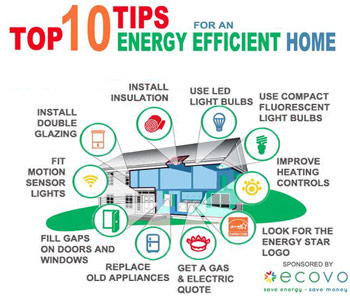
“Every day,” says Bernie Sanders, “we are paying more for energy than we should due to poor insulation, inefficient lights, appliances, and heating and cooling equipment—money we could save by investing in energy efficiency.”
The use of LED lightbulbs in homes and buildings is only one of many ways for reducing energy costs and CO2 emissions and achieving substantial reductions in electricity bills. Modern appliances such as washing machines, refrigerators and water heaters are much more efficient and cheaper to run than older models, and by replacing old windows, installing better insulation, and using solar water heaters, savings are so great that initial investments for upgrades typically pay for themselves through saved energy bills in just a few years. Wasted heat from water heaters can be further reduced through the use of timers and insulation.
Efficient Transportation
Transport was responsible for 28% of global final energy consumption in 2016 and is one of the biggest sources of greenhouse gas emissions.
Transport was responsible for 28% of global final energy consumption in 2016 and is one of the biggest sources of greenhouse gas emissions, with road-based modes of transport such as trucks, buses and cars emitting the most greenhouse gases. The use of modern computer-aided design and computer-aided manufacturing (CAD/CAM) methods, together with the employment of new lightweight materials, mandated improvements in mileage efficiency, improved engine technologies, hybrid cars, and plug-in electric vehicles have already produced gains in savings and reductions in emissions. Global sales of electric vehicles grew by 40% in 2016, mainly in China and Europe, and there are now more than 2 million electric vehicles worldwide, but this still represents less than 0.2% of the 1.2 billion light-duty vehicles (LDVs) on the road. Electric vehicles are much more efficient than diesel or gasoline alternatives but are not yet at a scale to have a significant influence on global LDV fuel economy. Moreover, sales of less efficient large passenger vehicles such as trucks and SUVs have increased, especially in the U.S., due to falling gasoline prices, leading to a reduction in the global rate of improvement in fuel efficiency.
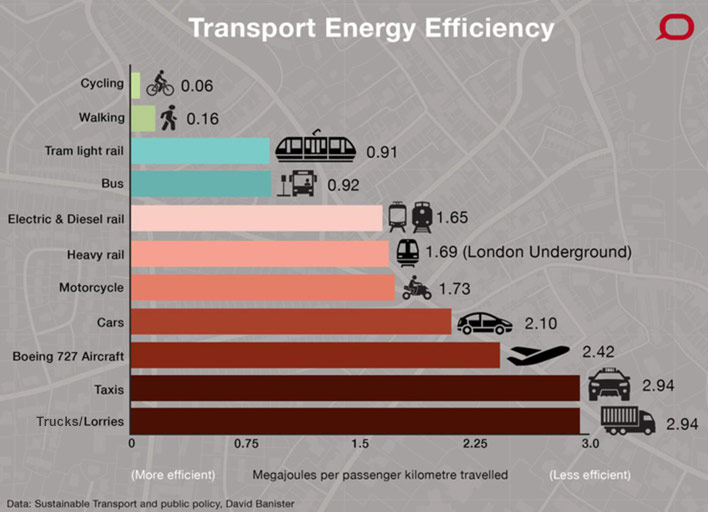
Mass transit systems such as bus and light rail networks in urban areas, along with complementary walking and cycling infrastructures, can sharply reduce both CO2 emissions and energy used, and also improve air quality with subsequent health benefits for local inhabitants.
According to the World Health Organization, “Safe, equitable, and energy-efficient urban transport can help achieve multiple health and sustainability goals. Shifting urban design and infrastructure investments into public transport networks that prioritize rapid bus transit or light rail over private vehicles can reduce the long-term trajectory of both air pollution and climate emissions generated by private transport – and improve health equity by providing those lacking cars with better mobility.”
A number of companies in the aviation industry have developed much lighter and stronger materials which, together with more efficient fuel use and aircraft design, have achieved gains in energy efficiency. Yet, despite these advances, the environmental impact of aviation continues to be of great concern. Lower fares and the consequent growth in the number of air passengers, along with the lack of taxes on aviation fuel worldwide mean that CO2 emissions from air travel and air freight are such that, unless market constraints are implemented, this growth will result in aviation emissions amounting to almost all of the annual global CO2 emissions budget by the year 2050.
Recycling
The recycling of commonly used materials such as paper, glass, plastics and aluminum is another area which results in huge reductions in energy use and CO2 emissions. According to Stanford University, in the U.S. alone, “the amount of lost energy from throwing away recyclable commodities such as aluminum cans and newspapers is equivalent to the annual output of 15 power plants.”
Aluminum never degrades and can be reused indefinitely with no need to bring new materials into the production cycle.
Aluminum is the most efficient of recyclable materials. It never degrades and can be reused indefinitely with no need to bring new materials into the production cycle. Processing recycled aluminum would reduce the energy used in the production of the metal from bauxite ore, currently one of the most energy-intensive processes in the global economy, by an incredible 95 percent. In other words, with the amount of energy it takes to make one new, unused aluminum can, you could make 20 recycled cans.
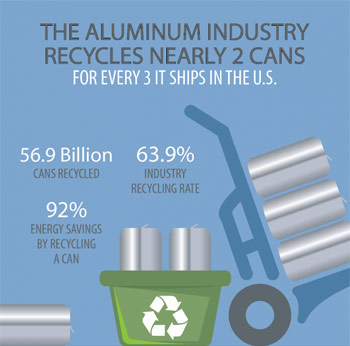
However, according to the Container Recycling Institute, sales of canned and bottled beverages in the U.S. have continued to grow over the last few decades but recycling of the containers has stagnated, resulting in higher rates of landfilling, incineration, littering and other negative environmental impacts.
Glass can be recycled indefinitely. The energy savings from recycling glass are relatively small, as recycled glass still needs to be re-melted at very high temperatures in order to make new glass products. However, according to a report by the Environmental Protection Agency, creating glass from recycled materials rather than raw materials generates 20 percent less air pollution and 50 percent less water pollution, as well as helping to reduce the size of landfills, preserve natural resources like sand, soda ash and limestone, and eliminate the costs involved with transporting these heavy materials. Recycled glass can also be turned into fiberglass, which in turn can be used in house insulation, and in the manufacture of bricks. Less energy is therefore required to create the bricks and, as the product is lighter, less energy is used in transport.
Paper is one of the most recycled materials in the world. Manufacturing recycled paper saves thousands of trees each year in the U.S. alone and uses only 60 percent of the energy required to produce paper from fresh pulp. Emerging research on biodegradable inks and even erasable paper could soon solve the problems faced by manufacturers of producing high quality, bright white paper due to ink residue.
Every year, more than 100 million tons of plastics are manufactured across the globe, yet only 14% of this amount is recycled. 8 million tons of plastic end up in our seas and oceans each year and some plastic materials can take hundreds of years to break down in a landfill. However, many plastics can be recycled and turned into items such as clothes, containers, bags, carpets, bottles, lumber, garden products, car components, furniture and insulation, to name just a few. Recycling a single plastic bottle can conserve enough energy to light a 10W LED bulb for up to 36 hours! It’s easy to see why recycling plastic is so important.
Barriers to Success
One of our main concerns has been to identify the financial and psychological barriers that have kept individuals, businesses, and governments from realizing efficiency’s great potential.
The main reason for home and business owners seems to be the initial expense. Myopic behavior and the need for instant gratification mean that, despite being informed that an initial outlay will be recovered through savings on bills, most home and business owners would still prefer to spend their money on something other than making their homes and businesses more energy efficient. A variety of financing options are being made available in some countries, including the U.S., to make it easier for homeowners and businesses to invest in energy efficiency. These include on-bill financing, property tax financing (also known as Property Assessed Clean Energy or PACE bond financing), energy service performance contracting (ESPC), and energy efficiency mortgages (EEMs). However, according to the ACEEE (American Council for an Energy Efficient Economy), “Financing programs for homeowners have typically drawn low participation rates and tend to attract educated and motivated homeowners who are the least in need of financing opportunities. Financing for those who are most in need – people with low or fixed incomes and poor credit – has had low success.”
Other barriers include a lack of education over environmental issues, climate change denial, greed and corruption on the part of construction and utility companies and politicians, and fears that a concern for the environment will lead to massive job loss, despite the evidence to the contrary. As the author Jeff Goodell states, “In reality, studies show that investments to spur renewable energy and boost energy efficiency generate far more jobs than oil and coal”.
Despite the impressive advances made in recent years in the field of energy efficiency and reductions in greenhouse gas emissions, a great deal of work still remains to be done, and we cannot afford to be complacent. In the words of Al Gore, “If we do not act now, future generations will look around and back at us and say, ‘You knew this—you knew what was going to happen to the planet and you decided to ignore it?’.”

The Future
Six Drivers of Global Change
Al Gore
No period in global history resembles what humanity is about to experience. Explore the key global forces converging to create the complexity of change, our crisis of confidence in facing the options, and how we can take charge of our destiny.

Our Choice
A Plan to Solve the Climate Crisis
Al Gore
We clearly have the tools to solve the climate crisis. The only thing missing is collective will. We must understand the science of climate change and the ways we can better generate and use energy.

The Big Ratchet
How Humanity Thrives in the Face of Natural Crisis
Ruth DeFries
Human history can be viewed as a repeating spiral of ingenuity—ratchet (technological breakthrough), hatchet (resulting natural disaster), and pivot (inventing new solutions). Whether we can pivot effectively from the last Big Ratchet remains to be seen.

The Sixth Extinction
An Unnatural History
Elizabeth Kolbert
With all of Earth’s five mass extinctions, the climate changed faster than any species could adapt. The current extinction has the same random and rapid properties, but it’s unique in that it’s caused entirely by the actions of a single species—humans.
In the series: Solutions
Related articles:
Further Reading »
External Stories and Videos
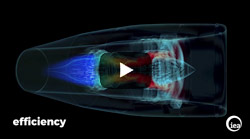
Watch: Digitalization & Energy: A new era in energy?
International Energy Agency
The IEA’s latest report, Digitalization & Energy, is the first-ever comprehensive effort to depict how digital technologies could transform the world’s energy systems.

